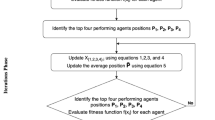Abstract
This paper presents a combined algorithm for optimum design of flexible rotor system supported by journal bearing. The proposed algorithm (Enhanced Genetic Algorithm, EGA) is the synthesis of a modified genetic algorithm and simplex method. A genetic algorithm (GA) is well known as a useful optimization technique for complex, nonlinear, and multi-optimization problems. The modified GA gives the candidate solutions in global search and then the solutions will be treated as initial values in the local search by the simplex method. The EGA is not only faster than the standard genetic algorithm, but also provides a more accurate solution. In addition, this algorithm can find both the global and the local optimum solutions at the same time. Through two standard test functions, the advantages of the proposed hybrid algorithm has been confirmed. Finally, to optimize a simple rotor system supported by journal bearing, EGA is applied. The radial clearance, length to diameter ratio and average viscosity of the journal bearing are chosen as the design parameters. The objective function is the minimization of a maximum quality factor of a flexible rotor system in the operating speed range.
Similar content being viewed by others
References
Rao, S. S., “Engineering Optimization: Theory and Practice,” John Wiley & Sons, Inc., 1996.
Nelder, J. A. and Mead, R., “A Simplex Method for Function Minimization,” Computer Journal, 7, pp. 308–313, 1965.
Box, M. J., “A New Method of Constrained Optimization and a Comparison with Other Methods,” Computer Journal, Vol. 8, No. 1, pp. 42–52, 1965.
Goldberg, D. E., “Genetic Algorithms in Search, Optimization and Machine Learning,” Addison-Wesley Longman Publishing Co., pp. 1–146, 1989.
Davis, L., “Handbook of Genetic Algorithms,” Van Nostrand Reinhold, pp. 3–23, 1991.
Trabia, M. B., “A Hybrid Fuzzy Simplex Genetic Algorithm,” Journal of Mechanical Design, Vol. 126, No. 6, pp. 969–974, 2005.
Jung, D. S. and Kim, C. Y., “Finite element model updating on small-scale bridge model using the hybrid genetic algorithm,” Structure and Infrastructure Engineering. Vol. 9, No. 5, pp. 481–495, 2013.
Deep, K., Das, K. N., “A novel hybrid genetic algorithm for constrained optimization,” International Journal of Systems Assurance Engineering and Management, Vol. 4, No. 1, pp. 86–93, 2013.
Garai, G., Chaudhurii, B. B., “A novel hybrid genetic algorithm with Tabu search for optimizing multi-dimensional functions and point pattern recognition,” Information Sciences, Vol. 221, pp. 28–48, 2013.
Xiuchang, H., Shiyin, X., Aihua, J., and Hongxing, H., “Modeling and optimization of floating raft systems in submarines under different objectives by using hybrid genetic algorithm,” Journal of Vibration and Contro, Vol. 8, No. 2, pp. 268–297, 2012.
Chang, H. C., Park, W. H., Yoon, K. B., Kim, T. K., Lee, D. H., Jung, W. S., “Inverse estimation of properties for charring material using a hybrid genetic algorithm,” Journal of Mechanical Science and Technology, Vol. 25, No. 6, pp. 1429–1437, 2011.
Choi, B. G. and Yang, B. S., “Multi-objective Optimization of Rotor-Bearing System with Dynamic Constraints Using IGA Algorithm,” Trans. ASME: J. Eng. Gas Turbines and Power, 123, pp. 78–81, 2001.
Kim, Y. H., Tan, A., Yang, B. S., Kim, W. C., Choi, B. K., and An, Y. S., “Optimum Shape Design of Rotation Shaft by ESO Method,” Journal of Mechanical Science and Technology, Vol. 21, pp. 1039–1047, 2007.
Hachimi, H., Ellaia, R., and Ehami, A., “A new hybrid genetic algorithm and particle swarm optimization,” Key Engineering Materials, Vol. 498, pp. 115–125, 2012.
Zhao, J. Q. and Wang, L., “Center Based Genetic Algorithm and its application to the stiffness equivalence of the aircraft wing,” Expert Systems with Application, Vol. 38, No. 5, pp. 6254–6261, 2011.
Yuan, Q., Qian, F., and Du, W., “A hybrid genetic algorithm with the Baldwin effect,” Information Sciences, Vol. 180, No. 5, pp. 640–652, 2010.
Kim, Y. C. and Yang, B. S., “Enhanced Genetic Algorithm for Fast and Accurate Global and Local Optimization Search,” Proc. International Congress on Sound and Vibration, July 2–6, Hong Kong, pp. 2143–2150, 2001.
Friswell, M. I. and Mottershead, J. E., “Finite Element Model Updating in Structural Dynamics,” Kluwer Academic Publishers, pp. 56–59, 1996.
Jong, K. A. D, “An analysis of the behavior of a class of genetic adaptive system,” University of Michigan Ann Arbor, pp. 266, 1975.
Hashimoto, H., “Optimum Design of High-Speed, Short Journal Bearings by Mathematical Programming,” Tribology Transactions, 40, pp. 283–293, 1997.
Yang, B. S., Lee, Y. H., Choi, B. K., and Kim, H. J., “Optimum design of short journal bearing by artificial life algorithm,” Tribology International, 34, pp. 427–435, 2001.
Song, J. D., Yang, B. S., Choi, B. K., and Kim H. J., “Optimum Design of Journal Bearing by Enhanced Artificial Life Optimization Algorithm,” Journal of Tribology International, Vol. 38, pp. 403–412, 2005.
Author information
Authors and Affiliations
Corresponding author
Rights and permissions
About this article
Cite this article
Gu, DS., Kim, YC., Lee, JM. et al. Optimum design of simple rotor system supported by journal bearing using enhanced genetic algorithm. Int. J. Precis. Eng. Manuf. 14, 1583–1589 (2013). https://doi.org/10.1007/s12541-013-0214-8
Received:
Accepted:
Published:
Issue Date:
DOI: https://doi.org/10.1007/s12541-013-0214-8




